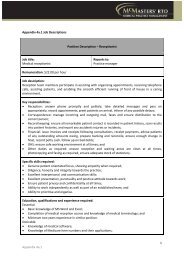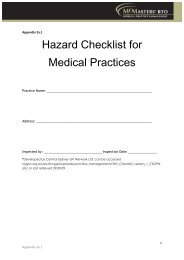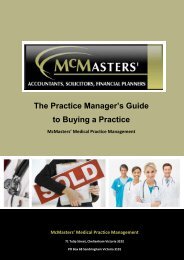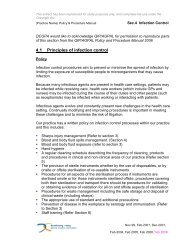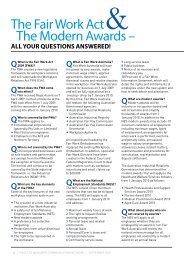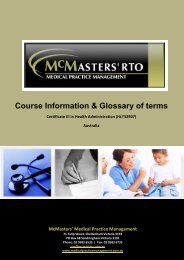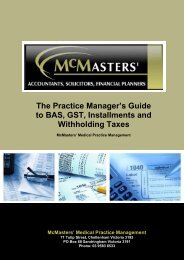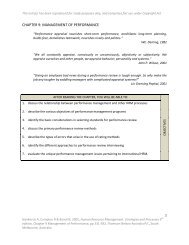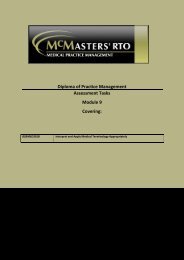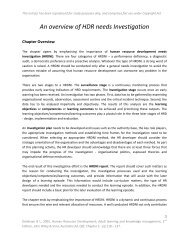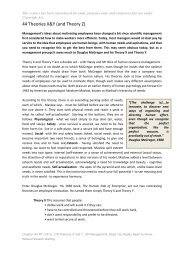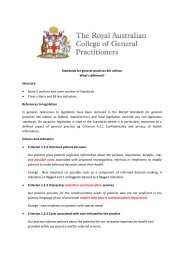The Practice Manager's Guide to Time Management
The Practice Manager's Guide to Time Management
The Practice Manager's Guide to Time Management
Create successful ePaper yourself
Turn your PDF publications into a flip-book with our unique Google optimized e-Paper software.
AN EXAMPLEAssume that just one hour a day, or five hours a week, can be saved by improving timemanagement. Add, say, five hours a week for say, fifty weeks, and the equivalent of more than fivefull working weeks are wasted each year. What could be done with an extra five weeks a year?Answer: see more patients and make more profit, presumably an extra 20%. (Yes, that’s right, anextra 20%). Fees will go up by 10% assuming a 50-hour week, but costs should virtually not go up atall. Assuming costs of 50%, this means profit will go up by 20%. Or more. Alternatively, the sameamount of work could be done, and an extra five weeks could be spent on the beach over summer.Or a bit of both could be achieved.This is why time should managed better. <strong>The</strong>re are two classic books relating <strong>to</strong> the area of timemanagement, which will be referred <strong>to</strong> in this module. <strong>The</strong>y are “<strong>The</strong> Effective Executive” by PeterDrucker” (Butterworth & Heineman 1967), and “<strong>The</strong> <strong>Time</strong> Trap” (Alec Mackenzie, American<strong>Management</strong> Association 1990). Both books are recommended reading. <strong>The</strong>y underpin virtually alllater writings on time management.Further reading:Kron J, 2010, Australian Doc<strong>to</strong>r, Torn over time, 9 April 201014.2 TIME MANAGAEMENT TECHNIQUES FOR DOCTORS AND MANAGERSIn part 2 of “<strong>The</strong> <strong>Time</strong> Trap”, Mackenzie identifies the twenty biggest time wasters, along withsuggestions on how <strong>to</strong> respond <strong>to</strong> them. <strong>The</strong> following extracts follow this suggested format, withsome additional comments and concerns added, purporting a sensible way <strong>to</strong> survey the range ofpractical tips for managing time better, and achieving enhanced results. As the practice manager is adelegate of the doc<strong>to</strong>r, and needs <strong>to</strong> assist the doc<strong>to</strong>r with the managerial aspects of the practice,doc<strong>to</strong>rs and practice managers should both benefit from the information. <strong>Practice</strong> managers havethe ability <strong>to</strong> assist principal doc<strong>to</strong>rs, as well as improve the management and productivity of thepractice as a whole.PatientsDoc<strong>to</strong>rs create income from treating patients, therefore, the more patients a doc<strong>to</strong>r treats; the moreincome a doc<strong>to</strong>r can generate for the practice. This does not mean that a doc<strong>to</strong>r should see tenpatients an hour, as this habit will most likely result in reduced quality of the services, and will alsobe likely <strong>to</strong> breach various professional standards. Appropriate allocation of time is necessary inorder <strong>to</strong> provide an adequate service, while at the same time maintaining realistic time efficiencies.A common concern amongst general practitioners is that patients consume much of the doc<strong>to</strong>r’stime on “small talk”, and only get <strong>to</strong> the point of their visit <strong>to</strong>wards the end of the consultation. Thismeans that valuable time is spent on ‘socialising’ with patients, which could be more efficiently used<strong>to</strong> provide medical advice. It also means that some patients “steal” away from the doc<strong>to</strong>r’s time,5



